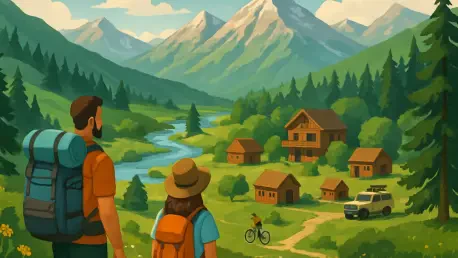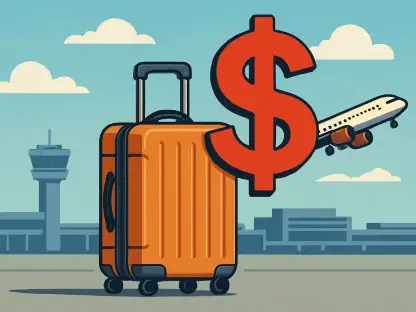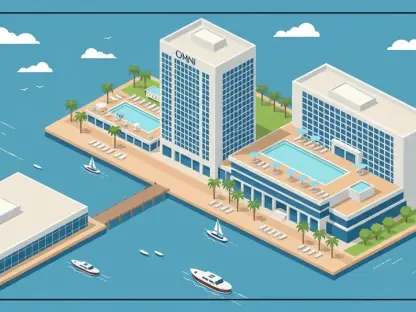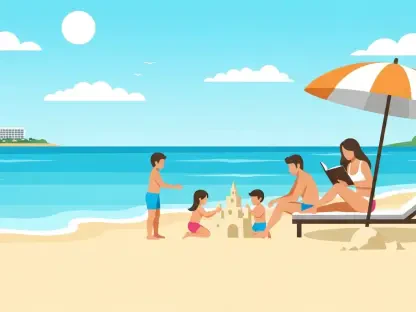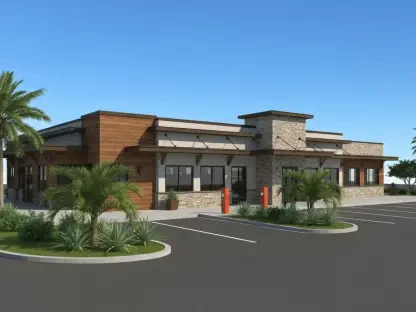Tucked away in the breathtaking Altay Mountains of Eastern Kazakhstan, Katon Karagay emerges as a hidden treasure, often compared to the Swiss Alps for its untouched landscapes of dense forests, shimmering glaciers, and pristine lakes, making it a captivating sanctuary of nature. This remote region, sharing borders with Russia, China, and Mongolia, stands as one of the last bastions of wild beauty in the country, a place that feels almost otherworldly in its serenity. Yet, beneath the surface of this idyllic setting lies a pressing dilemma that could reshape its future. As the push for economic growth through tourism gains momentum, a critical question arises: can Katon Karagay embrace development without sacrificing the very essence of its unspoiled charm? The region grapples with severe depopulation and crumbling infrastructure, making tourism seem like a lifeline for survival. However, the specter of environmental degradation looms large, threatening to turn this paradise into a cautionary tale of progress at nature’s expense. This complex struggle between preservation and modernization sets the stage for a deeper exploration of what lies ahead for this unique corner of the world.
The Human Cost of Isolation
Katon Karagay’s dramatic population decline paints a stark picture of a region struggling to hold onto its identity. Once a thriving community of nearly 40,000 people, the area now houses just 17,000, with many young residents fleeing to urban centers for better education, healthcare, and job prospects. This exodus has left behind aging villages where deaths far outnumber births, creating a demographic imbalance that threatens the continuity of cultural traditions and local heritage. Ghost towns dot the landscape, silent witnesses to a way of life slipping away. Efforts to stem this tide through educational programs and economic incentives are in motion, but the scale of the challenge remains daunting. The loss of human presence not only weakens the social fabric but also raises concerns about who will steward the land if the community continues to shrink, making the stakes for sustainable development even higher.
Beyond the numbers, the social impact of depopulation reverberates through every aspect of life in Katon Karagay. Elderly residents, often the sole inhabitants of once-vibrant hamlets, struggle to maintain traditional practices like deer herding and craftsmanship that have defined the region for generations. The absence of younger voices means fewer advocates for the area’s needs, leaving it vulnerable to decisions made by distant authorities or external investors. Community initiatives aim to reverse this trend by fostering local pride and creating opportunities that might entice families to stay or return. Yet, the underlying tension remains—how can a region so tied to its natural environment thrive without a robust population to support and protect it? This human element adds a poignant layer to the debate over tourism, as economic revival must also address the very real risk of cultural erosion.
Economic Dependence on Nature’s Bounty
The economy of Katon Karagay is deeply intertwined with its natural resources, a relationship that both sustains and constrains the region. Local livelihoods depend on activities such as deer herding for antler-based traditional medicine, honey production, and the collection of non-timber forest products. These practices, rooted in centuries of harmony with the land, provide a modest but vital income for many families. Tourism, particularly in the forms of ecotourism and cultural experiences, is increasingly viewed as a key driver for growth, promising jobs that could anchor younger generations to their homeland. Government and social organizations champion this potential, seeing visitors as a means to inject much-needed revenue into the area. However, there is a palpable undercurrent of anxiety that rapid or poorly managed development might disrupt the delicate balance with nature, jeopardizing the resources that form the backbone of the local economy.
This reliance on the environment also underscores the fragility of Katon Karagay’s economic future. The pristine landscapes that draw tourists are the same ones that support traditional industries, creating a paradox where growth in one area could undermine another. If tourism surges without careful oversight, the influx of visitors might degrade forests, disturb wildlife, or pollute water sources, directly impacting activities like honey production or therapeutic practices tied to the region’s unique ecosystem. Stakeholders recognize the need for a model that prioritizes sustainability, ensuring that economic benefits do not come at the expense of the natural wealth that defines the area. The challenge lies in crafting policies and practices that protect these resources while still opening doors to financial stability, a balancing act that remains at the heart of the region’s aspirations.
Infrastructure Challenges and Environmental Risks
Infrastructure development in Katon Karagay presents a classic double-edged sword, promising accessibility while threatening the region’s untouched allure. Projects like a new road and a nearby airport are designed to shorten the grueling six-to-eight-hour journey from Ust Kamenogorsk, making the area more reachable for tourists and potentially boosting the local economy. Such improvements are seen as essential for reversing economic stagnation, allowing easier access for visitors and facilitating the transport of goods. Yet, the sight of bulldozers tearing through ancient forests to pave these paths serves as a grim reminder of the environmental toll. The fear among locals is that enhanced connectivity could lead to an overwhelming influx of people, placing unbearable strain on a fragile ecosystem that has remained largely undisturbed for centuries.
The environmental risks tied to infrastructure expansion extend beyond mere aesthetics, touching on the very survival of Katon Karagay’s biodiversity. Increased human traffic could disrupt wildlife habitats, pollute pristine lakes, and accelerate erosion in an area already vulnerable to natural shifts. Many residents and environmental advocates argue that the current inaccessibility, while a barrier to growth, inadvertently shields the region from overexploitation. The debate intensifies around how to modernize without inviting destruction, with some suggesting that infrastructure projects should be scaled back or paired with strict protective measures. The tension between the need for progress and the imperative to preserve nature’s sanctity highlights a broader struggle, one where every step forward must be weighed against potential irreversible loss to the landscape that defines this paradise.
The Dual Nature of Tourism’s Impact
Tourism in Katon Karagay already draws tens of thousands of visitors annually from across Kazakhstan, Russia, and Europe, captivated by the region’s raw, unspoiled beauty. Local residents have embraced this opportunity, transforming their homes into guesthouses and yurts, serving homemade meals, and sharing traditional experiences that offer a glimpse into their way of life. This burgeoning industry provides a vital source of income, supporting families and fostering a sense of pride in showcasing their heritage. Government grants and workshops have further encouraged such initiatives, equipping communities with the tools to host guests effectively. The economic uplift is undeniable, yet it comes with an undercurrent of unease about what scaling up might mean for the region’s future, as the line between opportunity and overreach feels perilously thin.
Despite the benefits, the specter of mass tourism casts a long shadow over Katon Karagay’s tranquil landscapes. Many locals and tourism workers express concern that a surge in visitor numbers could shatter the peace that defines the area, drive away wildlife, and erode the cultural authenticity that attracts people in the first place. The potential for overcrowding in sensitive natural zones raises alarms about litter, habitat destruction, and strain on limited resources. There is a shared sentiment that the unique allure of the region lies in its untouched state, a quality that could be lost if development prioritizes quantity over quality. Striking a balance where tourism supports the economy without compromising the environment or local identity remains a critical challenge, one that demands careful thought and proactive measures.
Community Perspectives on Growth
Voices from within Katon Karagay reflect a nuanced blend of optimism and apprehension regarding the rise of tourism. Many residents welcome the financial benefits, appreciating how hosting visitors has breathed new life into struggling households and provided a platform to share their customs. Community gatherings often buzz with discussions on how to maximize these opportunities, with locals eager to ensure that benefits are felt directly at the grassroots level. Initiatives such as hospitality training programs are gaining traction, empowering individuals to turn their homes into sustainable sources of income. Yet, beneath this enthusiasm lies a profound concern for preserving their way of life, with many questioning whether the influx of outsiders might dilute the very traditions they aim to showcase, creating a complex emotional landscape.
This duality of hope and fear is further evident in the collective push for a measured approach to development. Residents often voice a deep-rooted connection to their land, viewing it not just as a resource but as an integral part of their identity. At local forums, there is a recurring plea for strategies that prioritize long-term preservation over short-term gains, with suggestions ranging from limiting tourist access to certain areas to fostering cultural education for visitors. The community’s desire for balance is palpable, as they seek to harness tourism’s potential while safeguarding the serene environment and heritage that define their home. This ground-level perspective adds a critical dimension to the broader debate, emphasizing that any path forward must honor the voices of those who know the region best.
Pathways to Sustainable Tourism
A growing consensus in Katon Karagay points toward sustainable tourism as the most viable way to protect the region while fostering economic growth. Proposals for strict controls, such as issuing permits to cap visitor numbers in ecologically sensitive zones, are gaining support among stakeholders. These measures aim to prevent overcrowding and minimize environmental impact, ensuring that the area’s natural beauty remains intact for future generations. Additionally, educational campaigns targeting tourists are under consideration, designed to promote responsible behavior and raise awareness about the fragility of the ecosystem. Concepts like “zero emissions and minimal waste” are being floated as guiding principles, reflecting a forward-thinking vision that aligns with global trends in ecotourism and conservation.
Implementing these sustainable strategies requires collaboration across multiple levels, from local communities to government bodies. Ideas for community-driven tourism models are taking shape, where residents play a central role in decision-making and directly reap the rewards of visitor spending. Training programs to enhance hospitality skills are paired with efforts to improve local infrastructure in environmentally friendly ways, such as using renewable energy sources for guesthouses. There is also talk of developing high-end, low-volume tourism offerings that attract discerning travelers willing to pay a premium for exclusive experiences, thereby reducing foot traffic while maximizing revenue. These approaches signal a cautious but determined effort to redefine tourism in a way that preserves Katon Karagay’s essence, offering a potential blueprint for other fragile regions facing similar dilemmas.
Navigating the Future of a Fragile Eden
The journey of Katon Karagay reflects a delicate dance between progress and preservation, a narrative that unfolds with cautious steps over time. Stakeholders, from local villagers to policymakers, stand united in their resolve to shield this rare sanctuary, even as they wrestle with the practicalities of economic survival. The tension between modern infrastructure demands and the sanctity of untouched landscapes remains a defining struggle, one that demands innovative solutions and unwavering commitment. Looking back, the debates over tourism’s scale and impact highlight a universal challenge faced by many remote regions, where every decision carries weighty consequences for both nature and community.
Reflecting on this pivotal moment, the path ahead for Katon Karagay hinges on actionable strategies that prioritize long-term sustainability. Establishing robust frameworks for controlled tourism, such as digital ticketing systems to manage visitor numbers, could serve as a starting point. Partnerships between local entities and environmental experts might yield tailored conservation plans, ensuring that development aligns with ecological limits. Furthermore, investing in community education and empowerment will be crucial, equipping residents with the tools to shape their future while safeguarding their heritage. As global attention turns to balancing human needs with environmental stewardship, Katon Karagay’s story offers valuable lessons, urging a renewed focus on collaboration and vigilance to protect such irreplaceable treasures for generations yet to come.
